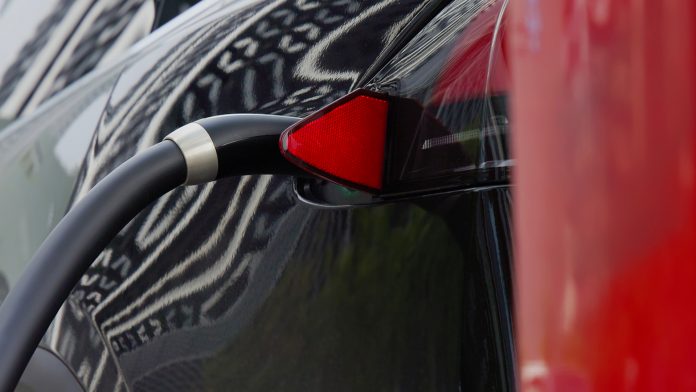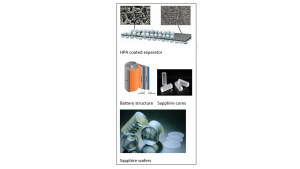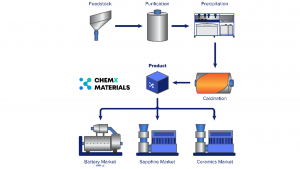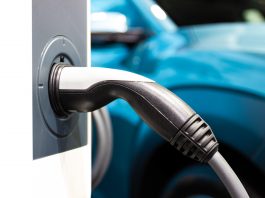High purity alumina is used in lithium-ion batteries to coat the separator between the anode and cathode, which improves its thermal capacity. ChemX Materials Ltd explains the varied benefits of significantly improving the processing technology for high purity alumina.
ChemX Materials Ltd (ASX:CMX) is an ASX listed materials technology company focused on supplying high purity materials into the energy transition and decarbonisation markets. There are three projects presently under development:
- The HiPurA® high purity alumina (HPA) processing technology is a proven and innovative technology for producing >99.99% (4N) HPA for the lithium battery and synthetic sapphire markets with the initial plant located in Perth, Western Australia;
- The Jamieson Tank Manganese project is located on the Eyre Peninsula in South Australia, a Tier 1 mining and exploration jurisdiction. The focus of this project is the development of lithium battery manganese cathode precursor grade products. The project is currently undergoing on-ground exploration and metallurgical test work leading to manganese sulphate for battery cathodes; and
- The Kimba Kaolin / Halloysite project is located on the Eyre Peninsula in South Australia. As well as focusing on the traditional kaolin markets, the use of kaolin in the decarbonisation of industrial processes and the use of halloysite in hydrogen/oxygen storage, CO2 capture and pharmaceuticals are being investigated
The HiPurA® HPA technology is the main focus for development in the short term. The process has significant advantages over current or proposed production technologies:
- Scalability enables production to be increased relatively simply and quickly as demand increases;
- Being modular allows for the development of production facilities close to battery production facilities, reducing the length and carbon footprint of the logistics chain;
- As the process doesn’t use aluminium metal as a feedstock and is significantly lower in energy consumption, the carbon footprint of the production is lower than existing processes;
- It is not tied to any mining operation, avoiding the timeframe and cost of establishing a mining operation; and
- There is excellent potential to produce >99.999% (5N), or higher purity, HPA.
The HiPurA® technology provides the opportunity to develop HPA with different properties and characteristics. In addition to HPA, the process can produce battery cathode precursor-grade aluminium salts and boehmite.
ChemX will bring the HiPurA® technology to life with the commissioning of a micro-plant in Q2 2022 capable of producing 2-5kg per day with a larger pilot plant being designed and expected to be commissioned in 12-18 months. Following the commissioning of the pilot plant, ChemX expects construction times for commercial-scale plants to be reduced to under 12 months.
As well as establishing the operational parameters of the process, ChemX is looking to collaborate with end-users to develop products with the optimum purity and morphological specifications needed for their process. The flexibility of the HiPurA® process enables the production of different products, morphologies and purities within a single plant by changing the operating conditions.
Uses of high purity alumina
There are two significant consumers of high purity alumina, lithium-ion batteries and synthetic sapphire. The requirement for each use is different; batteries require a purity of 99.99% (4N, <100g of impurities per tonne of product) and a limited range of shapes and sizes, whilst sapphire manufacturers require solid pucks of 99.999% (5N) purity (<10g of impurities per tonne). The next generation of batteries and sapphire are likely to require even higher purities of 99.999% and 99.9999% (6N), respectively.
In batteries, the HPA is used to coat the separator between the anode and cathode to improve its thermal capacity, thereby reducing the risk of thermal runaway and the well-publicised, but rare, fires in mobile phones and electric vehicles. There is also research into using HPA to coat the anode and/or cathode to provide stability to the battery, reduce the use of cobalt in the battery chemistry and decrease the losses of capacity commonly encountered in the initial charge-discharge cycle.
The main markets for synthetic sapphire are for LED and semiconductor substrates. The unique properties of sapphire make it ideal for scratchproof windows and lenses on high-end electronic devices and optical components.
The HiPurA® high purity alumina process
The patented HiPurA® process significantly improves the techniques outlined in the following section. The feedstock does not need to be either highly purified or mined and is available in bulk quantities in almost every country.
The feedstock is leached, filtered to remove a minimal (<0.1%) amount of insoluble impurities and fed into the purification process. The purified product can be used to produce two different products, high purity aluminium salts, or high purity alumina. The only solid waste from the process is generated at this stage and is expected to be <5kg per tonne of HPA produced:
- The high purity aluminium salts are used as precursors to NCA (nickel-cobalt-aluminium) cathodes for lithium-ion batteries; and
- The high purity alumina can be used on the separator in lithium batteries or for sapphire production.
The current process produces a high 4N pure product which is expected to be further improved by repeating the purification process to achieve 5N and potentially 6N products. Testwork for this step is planned for Q3 2022.
One of the main by-products of the HiPurA® process is a highly desirable chemical product used in many industries, including agriculture and chemical manufacture, further reducing ‘waste’ from the process.
The HiPurA® process operates all stages, other than the final phase changing calcination, at ambient temperature. The reagents used are globally available and relatively low cost. Solid waste is minimal, while liquid waste can be treated at a low cost to recover water for reuse within the process. The overall process is designed to be water neutral by recycling within the process.
The potential to produce alternative products, i.e. high purity aluminium salts and high purity alumina, is a significant advantage over the other processes that can only produce HPA. The capability to produce 5N and potentially 6N products is also a substantial advantage over the USBM process outlined below. No special construction materials are required as the process does not use highly corrosive chemicals or produce corrosive gas streams.
Further work is underway to investigate alternative feedstock for use in the process. These alternatives include aluminous wastes from other industrial processes to reduce the overall environmental impact.
The scalability and modularity of the process make the construction and operation of several production facilities viable. This allows the potential to construct a facility close to an end buyer, e.g. a gigafactory or sapphire producer, to produce bespoke product(s) required by the consumer. This flexibility of scale and location combined with locally sourced feedstock and reagents results in a product with an extremely low carbon footprint.
Current production methods of high purity alumina
The current main route for producing high purity alumina is the alkoxide process. The other alternative technology that has been proposed is the US Bureau of Mines (USBM) alumina process. The former process uses high purity aluminium as the starting material, reacting it with an alcohol and then reacting the alkoxide with water to produce the alumina. The feedstock is expensive as the aluminium metal is refined to a higher purity than typical aluminium metal and also carries with it the significant carbon and environmental footprint associated with the Bayer and smelter processes. This method can produce all purities of HPA up to 6N; however, it can not produce aluminium salts.
The USBM process, which has been known since the 1940s, uses a much lower cost feedstock in the form of clay or other low-value aluminous minerals. Several proponents of this technology are using kaolin as a feedstock to the USBM process to produce HPA. The process is based on the change in solubility of aluminium chloride in hydrochloric acid; as the acid concentration increases, the solubility decreases. The kaolin is mined, beneficiated, calcined, and leached in hydrochloric acid at 80-105°C.
After filtration, the leach solution has hydrogen chloride gas injected to increase the acid concentration and precipitate aluminium chloride. The leach residue, typically >1-2 tonnes per tonne of HPA produced, is neutralised and disposed of. The slurry is filtered, and the aluminium chloride is redissolved in clean water. The filtrate is treated to regenerate the HCl gas for use within the process. The cycle of precipitation and redissolution repeats until the impurities have been removed; generally, at least three cycles are required for 4N purity.
The final aluminium chloride product is filtered and calcined, typically in two stages. The first stage operates at 800°C and separates the chloride from the aluminium producing a gas stream composed of HCl and steam and an aluminium oxide. The gas stream is treated to recover the HCl, which is recycled within the process. The aluminium oxide is then heated to 1,200°C to change it to the alpha crystallographic form required by battery manufacturers. It is believed that the USBM process will struggle to economically make the higher purity products due to a significant increase in the number of purification cycles required.
The cost of the USBM process is primarily centred around the recycling of the gaseous hydrogen chloride. The plant needs to be sufficiently large to benefit from the economy of scale within the very energy-intensive HCl regeneration process to achieve economic success. This, combined with the necessity to construct the plant using expensive chemically resistant materials, result in a high CAPEX. At this time, the USBM process is not in commercial production.
The future of HPA
ChemX Materials aims to be one of the most responsive manufacturers of high purity alumina products. We will be engaging with leading companies and researchers to translate new ideas into commercial products. There is a clear trend towards higher purity materials being used in both batteries and sapphire; thus, the capability to produce 5N and 6N will become increasingly important. Other advances include coating the cathode and/or anode material with nanoparticles of HPA to improve battery performance by notably reducing the drop in capacity after the initial discharge. The size, morphology and porosity of the HPA in batteries is also an area where there is likely to be significant developments.
The HiPurA® team is already developing methods to produce novel materials at a small scale (up to 5kg per day) using a dedicated micro-plant, thereby allowing the more innovative consumers access to relatively large volumes of developmental materials to trial before large scale adoption. The flexibility of the HiPurA® Process is such that existing plants may be modified to produce novel materials.
ChemX materials
ChemX is focused on developing materials for new and developing technologies for use in the energy transition and decarbonisation processes. The HiPurA® technology has been designed to produce HPA in a scalable process that can expand production as demand requires. The additional benefits of being capable of producing battery cathode precursor aluminium salts and boehmite provide a wide range of materials for the lithium battery supply chain. The product’s flexibility also allows access to other markets presently limited by purity and/or morphology.
The modularity of the process allows production to be co-located with the end-user facilities; combining this with the use of locally sourced feedstocks and reagents will significantly reduce the length of the logistics chain, reduce the potential of supply disruptions and reduce carbon footprint. This also allows for the specific product specifications for the co-located facilities to be optimised to the end-use, ensuring greater quality continuity.
ChemX will have its micro-plant operational in Q2 2022 and be capable of producing up to 5kg per day, and the larger pilot plant will be developed within 12-18 months. ChemX is currently working with HPA, aluminium cathode precursor salts and boehmite buyers to develop products with the unique specifications required for their process.
Please note, this article will also appear in the ninth edition of our quarterly publication











